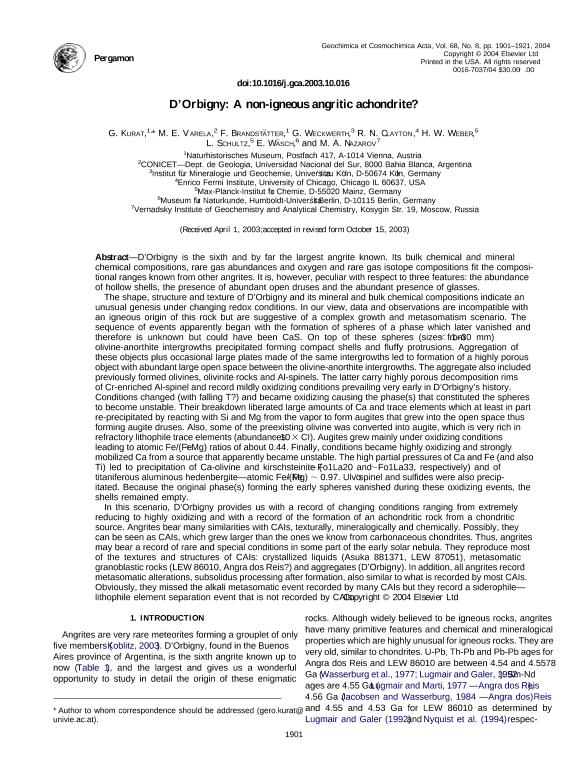Artículo
D'Orbigny: A non-igneous angritic achondrite?
Kurat, Gero; Varela, Maria Eugenia ; Brandstaetter, Franz; Weckwerth, G.; Clayton, R.; Weber, H. W.; Schultz, L.; Wäsch, E.; Nazarov, M.
; Brandstaetter, Franz; Weckwerth, G.; Clayton, R.; Weber, H. W.; Schultz, L.; Wäsch, E.; Nazarov, M.
 ; Brandstaetter, Franz; Weckwerth, G.; Clayton, R.; Weber, H. W.; Schultz, L.; Wäsch, E.; Nazarov, M.
; Brandstaetter, Franz; Weckwerth, G.; Clayton, R.; Weber, H. W.; Schultz, L.; Wäsch, E.; Nazarov, M.
Fecha de publicación:
12/2004
Editorial:
Pergamon-Elsevier Science Ltd
Revista:
Geochimica et Cosmochimica Acta
ISSN:
0016-7037
Idioma:
Inglés
Tipo de recurso:
Artículo publicado
Clasificación temática:
Resumen
D'Orbigny is the sixth and by far the largest angrite known. Its bulk chemical and mineral chemical compositions, rare gas abundances and oxygen and rare gas isotope compositions fit the compositional ranges known from other angrites. It is, however, peculiar with respect to three features: the abundance of hollow shells, the presence of abundant open druses and the abundant presence of glasses. The shape, structure and texture of D'Orbigny and its mineral and bulk chemical compositions indicate an unusual genesis under changing redox conditions. In our view, data and observations are incompatible with an igneous origin of this rock but are suggestive of a complex growth and metasomatism scenario. The sequence of events apparently began with the formation of spheres of a phase which later vanished and therefore is unknown but could have been CaS. On top of these spheres (sizes from < 1-30 mm) olivine-anorthite intergrowths precipitated forming compact shells and fluffy protrusions. Aggregation of these objects plus occasional large plates made of the same intergrowths led to formation of a highly porous object with abundant large open space between the olivine-anorthite intergrowths. The aggregate also included previously formed olivines, olivinite rocks and Al-spinels. The latter carry highly porous decomposition rims of Cr-enriched Al-spinel and record mildly oxidizing conditions prevailing very early in D'Orbigny's history. Conditions changed (with falling T?) and became oxidizing causing the phase(s) that constituted the spheres to become unstable. Their breakdown liberated large amounts of Ca and trace elements which at least in part re-precipitated by reacting with Si and Mg from the vapor to form augites that grew into the open space thus forming augite druses. Also, some of the preexisting olivine was converted into augite, which is very rich in refractory lithophile trace elements (abundances ∼ 10 × CI). Augites grew mainly under oxidizing conditions leading to atomic Fe/(Fe+Mg) ratios of about 0.44. Finally, conditions became highly oxidizing and strongly mobilized Ca from a source that apparently became unstable. The high partial pressures of Ca and Fe (and also Ti) led to precipitation of Ca-olivine and kirschsteinite (∼Fo1La20 and ∼Fo1La33, respectively) and of titaniferous aluminous hedenbergite-atomic Fe/(Fe+Mg) ∼ 0.97. Ulvöspinel and sulfides were also precipitated. Because the original phase(s) forming the early spheres vanished during these oxidizing events, the shells remained empty. In this scenario, D'Orbigny provides us with a record of changing conditions ranging from extremely reducing to highly oxidizing and with a record of the formation of an achondritic rock from a chondritic source. Angrites bear many similarities with CAIs, texturally, mineralogically and chemically. Possibly, they can be seen as CAIs, which grew larger than the ones we know from carbonaceous chondrites. Thus, angrites may bear a record of rare and special conditions in some part of the early solar nebula. They reproduce most of the textures and structures of CAIs: crystallized liquids (Asuka 881371, LEW 87051), metasomatic granoblastic rocks (LEW 86010, Angra dos Reis?) and aggregates (D'Orbigny). In addition, all angrites record metasomatic alterations, subsolidus processing after formation, also similar to what is recorded by most CAIs. Obviously, they missed the alkali metasomatic event recorded by many CAIs but they record a siderophile-lithophile element separation event that is not recorded by CAIs.
Archivos asociados
Licencia
Identificadores
Colecciones
Articulos(ICATE)
Articulos de INST.D/CS ASTRONOMICAS D/LA TIERRA Y DEL ESPACIO
Articulos de INST.D/CS ASTRONOMICAS D/LA TIERRA Y DEL ESPACIO
Citación
Kurat, Gero; Varela, Maria Eugenia; Brandstaetter, Franz; Weckwerth, G.; Clayton, R.; et al.; D'Orbigny: A non-igneous angritic achondrite?; Pergamon-Elsevier Science Ltd; Geochimica et Cosmochimica Acta; 68; 8; 12-2004; 1901-1921
Compartir
Altmétricas



